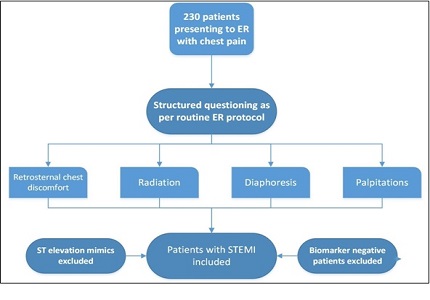To study the correlation of symptoms of angina with the diagnosis of ST Segment Elevation Myocardial Infarction (STEMI)
Abstract
Introduction: Chest pain is amongst the commonest causes of visits to the emergency department. A rapid assessment with a prompt evaluation with an electrocardiogram clinches the diagnosis in most cases. However, with ever increasing strain on our limited resources, patient reported symptoms are central to initial assessment and must decide the course of action. Although considered ominous signs requiring further, often emergent, assessment, data on correlation of symptoms of angina with ST segment elevation is limited in contemporary literature.
Methodology: 230 patients with biomarker proven ST segment elevation myocardial infarction (STEMI) were studied and assessed for frequency of the four, patient reported, cardinal symptoms of angina, namely retrosternal chest discomfort, diaphoresis, palpitations and radiation. We assessed the relative presence or absence of these supposedly cardinal symptoms of angina and set out to classify the most important symptoms of angina.
Results: Our study shows that presence of three or more above symptoms is associated with a much higher possibility of an actual STEMI as opposed to only one symptom. Furthermore, a measurable increase in the probability of MI exists, when the number of patient reported symptoms increases from none to all four, as mentioned above. Though the study also reaffirmed the association between hypertension and Type 2 Diabetes Mellitus with acute coronary syndromes, our study was neither powered, nor designed to study this association.
Conclusions: Patient reported symptoms have a direct and additive correlation with STEMI. A quick but detailed history in the emergency department is of paramount importance to identify high risk patients.
Downloads
References
Hurst F. Hurst's The Heart. 13th ed. Furster Hurst KH, editor. USA: McGraw Hills and Sons; 2016 2016. 2258 p.
Malik MA, Alam Khan S, Safdar S, Taseer IU. Chest Pain as a presenting complaint in patients with acute myocardial infarction (AMI). Pak J Med Sci. 2013 Apr;29(2):565-8.
Peter Libby DM, Douglas Zipes, Robert Bonow. Braunwald Heart Disease. 10th ed. Braunwald E, editor. USA: Elsevier Saunders; 2016. 1931 p.
Bellolio MF, Sangaralingham LR, Schilz SR, Noel-Miller CM, Lind KD, Morin P, Noseworthy PA, Shah ND, Hess EP. Observation or inpatient: Impact of patient disposition on outcomes and utilization among emergency department patients with chest pain. Acad Emerg Med. 2016 Oct 14. doi: https://doi.org/10.1111/acem.13116. [Epub ahead of print]
Chandra A, Lindsell CJ, Limkakeng A, Diercks DB, Hoekstra JW, Hollander JE, et al. Emergency physician high pretest probability for acute coronary syndrome correlates with adverse cardiovascular outcomes. Acad Emerg Med. 2009;16(8):740-8.
Cubukcu A, Murray I, Anderson S. What's the risk? Assessment of patients with stable chest pain. Echo Res Pract. 2015 Jun 1;2(2):41-8. doi: https://doi.org/10.1530/ERP-14-0110. Epub 2015 Mar 9.
Veronese G, Germini F, Ingrassia S, Cutuli O, Donati V, Bonacchini L, et al. Emergency physician accuracy in interpreting electrocardiograms with potential ST-segment elevation myocardial infarction: Is it enough? Acute Card Care. Published online 19 October 2016:pages 1-4. http://dx.doi.org/10.1080/17482941.2016.1234058.
Cervellin G, Rastelli G. The clinics of acute coronary syndrome. Ann Transl Med. 2016 May;4(10):191. doi: https://dx.doi.org/10.21037%2Fatm.2016.05.10.
Davies N. Treating ST-elevation myocardial infarction. Emerg Nurse. 2016;24(3):20-5.
Pandie S, Hellenberg D, Hellig F, Ntsekhe M. Approach to chest pain and acute myocardial infarction. S Afr Med J. 2016 Mar;106(3):239-45.
Rabasse P, Johnson C, Malik N. NICE guidelines for new chest pain: comparison of new and old services. Br J Nurs. 2013 May 9-22;22(9):524-8.
Gokhroo RK, Ranwa BL, Kishor K, Priti K, Ananthraj A, Gupta S, et al. Sweating: A Specific Predictor of ST-Segment Elevation Myocardial Infarction Among the Symptoms of Acute Coronary Syndrome: Sweating In Myocardial Infarction (SWIMI) Study Group. Clin Cardiol. 2016;39(2):90-5.
Jones MM, Somerville C, Feder G, Foster G. Patients' descriptions of angina symptoms: a qualitative study of primary care patients. Br J Gen Pract. 2010 Oct;60(579):735-41. doi: https://doi.org/10.3399/bjgp10X532378.
Kirchberger I, Meisinger C, Heier M, Kling B, Wende R, Greschik C, von Scheidt W, Kuch B. Patient-reported symptoms in acute myocardial infarction: differences related to ST-segment elevation: the MONICA/KORA Myocardial Infarction Registry. J Intern Med. 2011 Jul;270(1):58-64. doi: https://doi.org/10.1111/j.1365-2796.2011.02365.x. Epub 2011 Mar 17.
Wah W, Pek PP, Ho AF, Fook-Chong S, Zheng H, Loy EY, Chua TS, Koh TH, Chow KY, Earnest A, Pang J, Ong ME. Symptom-to-door delay among patients with ST-segment elevation myocardial infarction in Singapore. Emerg Med Australas. 2016 Oct 11. doi: https://doi.org/10.1111/1742-6723.12689. [Epub ahead of print]
Garvey JL, Zegre-Hemsey J, Gregg R, Studnek JR. Electrocardiographic diagnosis of ST segment elevation myocardial infarction: An evaluation of three automated interpretation algorithms. J Electrocardiol. 2016;49(5):728-32.
Pilbery R, Teare MD, Goodacre S, Morris F. The Recognition of STEMI by Paramedics and the Effect of Computer inTerpretation (RESPECT): a randomised crossover feasibility study. Emerg Med J. 2016 Jul;33(7):471-6. doi: http://dx.doi.org/10.1136/emermed-2015-204988. Epub 2016 Feb 10.
Savino PB, Sporer KA, Barger JA, Brown JF, Gilbert GH, Koenig KL, Rudnick EM, Salvucci AA. Chest Pain of Suspected Cardiac Origin: Current Evidence-based Recommendations for Prehospital Care. West J Emerg Med. 2015 Dec;16(7):983-95. doi: https://doi.org/10.5811/westjem.2015.8.27971. Epub 2015 Dec 11.



 OAI - Open Archives Initiative
OAI - Open Archives Initiative


